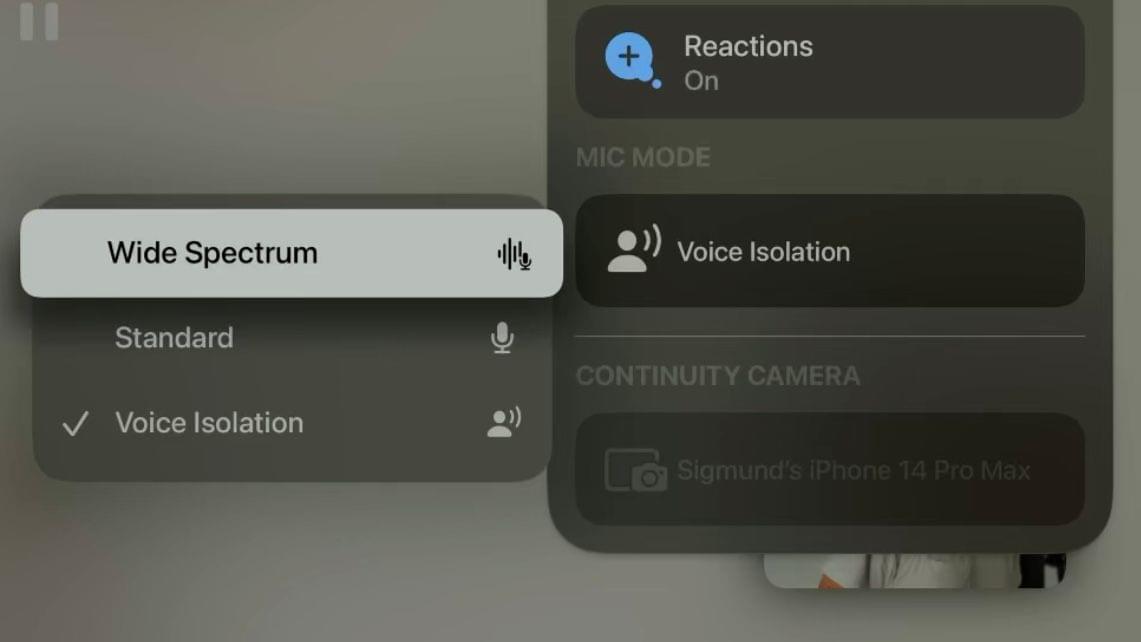FaceTime and Continuity Camera
When Continuity Camera’s name was repurposed last year – introduced as a new feature in macOS Ventura allowing the rear-facing camera of an iPhone to be used as a webcam – I reacted in a predictable fashion on social media:
Q. What feature announced yesterday did Apple TV need more than any other platform following last years addition of SharePlay?
A. Continuity Camera (I guess we’ll have to wait for a Apple Silicon based Apple TV for that) pic.twitter.com/CRdZCeZpKh
— Sigmund Judge (@sigjudge) June 7, 2022
Little did we know that Apple was already working on it. This is a feature with the potential to transform not only Apple TV as a platform but also our relationship with television screens and the spaces in which they reside.
Of course, Apple TV has no built-in camera, so FaceTime on Apple TV begins with an intuitive pairing process fit for the big screen that borrows heavily from the experience of connecting an iPhone for a Fitness workout. In this case, the FaceTime app prompts you to choose from a list of nearby devices to act as your camera. After accepting a prompt on your iPhone (or iPad), following a three-second countdown, your iPhone is paired and acts as the webcam to your Apple TV.
Initiating a call is easy and familiar for anyone who’s used FaceTime on any of Apple’s other platforms, thanks to a list view of previous calls and a + button that acts as a shortcut to your complete contact list. Being that the TV is normally set in a communal environment, it should be noted that critical contact data isn’t on display. For those friends and family who don’t use Apple’s products, there’s currently no clear option for sending FaceTime call invitations.
Other controls and options are in the shape of rounded buttons that toggle Center Stage and Portrait mode, along with options for the same 3D reactions,4also introduced in iOS 17 this year.
Unfortunately, Portrait mode may not be suited to the majority of average-sized living rooms since it relies on the distance between your seating and the foreground to work effectively. Instead, a missing feature at the time of writing with more universal appeal is Studio Light, which brightens the lighting on a subject’s face and dims the background, which is better suited for the dimly lit ambiance of movies and late-night entertainment.
As for audio settings, there aren’t any, at least not within the FaceTime app itself. Instead, to find options for Wide Spectrum, Standard, and Voice Isolation, you’ll need to head over to Control Center’s own Continuity Camera settings, but only once a call has been initiated.
Because FaceTime doesn’t yet make an appearance in Apps Settings in tvOS, there currently isn’t a way to set a default audio effect for previously paired devices ahead of time. If that option were to one day appear, I’d imagine the vast majority of users would choose Voice Isolation, which I’ll delve into momentarily.
It should be noted that you can only initiate FaceTime calls on Apple TV. Nor can you accept calls without accepting them from your connected device first, which may prove frustrating when dealing with dropped calls. Otherwise, FaceTime on Apple TV is everything you’d expect it to be, and while I don’t have enough friends to test its participant limit, one would imagine it should be the same as iOS.
When jumping out of the FaceTime app and into other parts of tvOS, video from other participants will follow in the form of Picture in Picture, which also comes with new layout options. These include Split View (which pushes the conversation to the right side, moving participants into a vertical row with the rest of the OS displayed slightly scaled down) and Full Screen.
SharePlay
As I noted at the very top, the main reason for my excitement for FaceTime and Continuity Camera is that SharePlay can now fulfill its true potential thanks to some fundamental changes in tvOS 17. Originally touted as a lockdown feature that came too late, I’ve always argued that if SharePlay’s biggest limitations were removed, we would all end up using the feature regularly.
In this latest iteration of SharePlay, Apple TV is the arbitrator of content playback, whereas before, content rights and connections were all channeled through iOS. This time around, iPhone is solely used to initiate the call and take care of audio and video; Apple TV takes care of the content, removing restrictions on what profile you decide to switch to mid-call. This, paired with native VPN support, allows users to SharePlay media across borders for the first time.
As good as that may sound, there is a catch. Because of regional restrictions and different rating boards across the world of entertainment, as well as the issues that can arise between different display standards, both SharePlay participants must play content from the same source and from the same region. As you can imagine, this time, not having to be logged into the same Apple ID as the one tied to your iPhone presents the possibility for region restriction workarounds with those you trust, but the less attention that is given to those, the better.

Third-party apps are also supported but watch out for region restrictions when SharePlaying with friends abroad.
Tapping on the SharePlay button offers a scrollable row of apps installed on both participants’ devices enabled for the feature, including some of the biggest names in streaming, Apple Arcade, Fitness workouts, and more. Apple Music, which was part of the initial SharePlay launch, isn’t yet available. However, with some features coming later this year on other platforms, it shouldn’t be long before we can listen to music together on Apple TV.
But what about audio feedback?
Voice Isolation may have been impressive on iOS, but its Apple TV integration is just the latest example of Apple showing off its algorithmic might. When mounting your iPhone directly above your television’s speakers, you’d imagine any attempt to use the iPhone’s onboard microphones might cause unwanted feedback. However, in my testing, that wasn’t the case at all.
Using my Apple Watch’s Noise monitoring app while testing demo material, it wasn’t until readings rose above 85db that the person on the other end of the call had any idea that I was playing something back. Apple has also done a great job balancing the explosions and dialogue of what you’re watching with a FaceTime conversation without negatively impacting either source.
Continuity Camera Elsewhere on Apple TV
Continuity Camera’s only other appearance across the OS comes courtesy of Apple Music’s Sing mode this year, with Apple TV 4K users now able to sing along to the lyrics while also appearing onscreen during a session, accompanied by a host of visual effects. They include Hazy, Stellar, Neon, Sparkle, and Aura, which will make you nostalgic for those early iPod commercials. The only items missing to make the experience complete are microphone inputs and a record function.
I’d imagine the debut of FaceTime in itself will spark the imaginations of developers going forward. If those developers do just a little bit of digging, they’ll realize that ReplayKit and the ability to stream have been a possibility for a long time. How long before creators launch reaction channels or live broadcasting via their Apple TVs? I’d hazard to guess it is not long at all. I’d also like to see Apple bring the iPad and Mac’s Photo Booth app to Apple TV.
- Reactions and the introduction of gestures can’t help but make me wonder if we’re just a step away from Siri via ASL and gesture control. ↩︎









